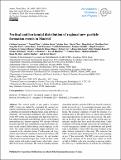Por favor, use este identificador para citar o enlazar a este item:
http://hdl.handle.net/10261/173021COMPARTIR / EXPORTAR:
 SHARE SHARE
 CORE
BASE CORE
BASE
|
|
| Visualizar otros formatos: MARC | Dublin Core | RDF | ORE | MODS | METS | DIDL | DATACITE | |

| Título: | Vertical and horizontal distribution of regional new particle formation events in Madrid |
Autor: | Carnerero, Cristina CSIC ORCID ; Pérez, Noemí CSIC ORCID; Reche, Cristina CSIC ORCID; Ealo, Marina CSIC; Titos, Gloria CSIC ORCID; Lee, Hong Ku; Eun, Hee Ram; Park, Yonghee; Dada, Lubna; Paasonen, Pauli; Kerminen, Veli Matti; Mantilla, Enrique; Escudero, Miguel CSIC ORCID; Gómez-Moreno, Francisco Javier; Alonso-Blanco, Elisabeth; Coz, Esther CSIC ORCID; Saiz-Lopez, A. CSIC ORCID; Temime-Roussel, Brice; Marchand, Nicolas; Beddows, D.C.S.; Harrison, Roy M.; Petäjä, Tuukka; Kulmala, Markku; Ahn, Kang-Ho; Alastuey, Andrés CSIC ORCID; Querol, Xavier CSIC ORCID | Palabras clave: | New particle formation NPF Ultrafine particles Aerosols |
Fecha de publicación: | 22-nov-2018 | Editor: | Copernicus Publications | Citación: | Atmospheric Chemistry and Physics 18 (22): 16601-16618 (2018) | Resumen: | The vertical profile of new particle formation (NPF) events was studied by comparing the aerosol size number distributions measured aloft and at surface level in a suburban environment in Madrid, Spain, using airborne instruments. The horizontal distribution and regional impact of the NPF events was investigated with data from three urban, urban background, and suburban stations in the Madrid metropolitan area. Intensive regional NPF episodes followed by particle growth were simultaneously recorded at three stations in and around Madrid during a field campaign in July 2016. The urban stations presented larger formation rates compared to the suburban station. Condensation and coagulation sinks followed a similar evolution at all stations, with higher values at urban stations. However, the total number concentration of particles larger than 2.5 nm was lower at the urban station and peaked around noon, when black carbon (BC) levels are at a minimum. The vertical soundings demonstrated that ultrafine particles (UFPs) are formed exclusively inside the mixed layer. As convection becomes more effective and the mixed layer grows, UFPs are detected at higher levels. The morning soundings revealed the presence of a residual layer in the upper levels in which aged particles (nucleated and grown on previous days) prevail. The particles in this layer also grow in size, with growth rates significantly smaller than those inside the mixed layer. Under conditions with strong enough convection, the soundings revealed homogeneous number size distributions and growth rates at all altitudes, which follow the same evolution at the other stations considered in this study. This indicates that UFPs are detected quasi-homogenously in an area spanning at least 17 km horizontally. The NPF events extend over the full vertical extension of the mixed layer, which can reach as high as 3000 m in the area, according to previous studies. On some days a marked decline in particle size (shrinkage) was observed in the afternoon, associated with a change in air masses. Additionally, a few nocturnal nucleation-mode bursts were observed at the urban stations, for which further research is needed to elucidate their origin. © Author(s) 2018. | Versión del editor: | https://doi.org/10.5194/acp-18-16601-2018 | URI: | http://hdl.handle.net/10261/173021 | DOI: | 10.5194/acp-18-16601-2018 |
| Aparece en las colecciones: | (IDAEA) Artículos |
Ficheros en este ítem:
| Fichero | Descripción | Tamaño | Formato | |
|---|---|---|---|---|
| Vertical and horizontal distribution of regional new particle.pdf | 11,35 MB | Adobe PDF |  Visualizar/Abrir |
CORE Recommender
SCOPUSTM
Citations
29
checked on 16-abr-2024
WEB OF SCIENCETM
Citations
23
checked on 25-feb-2024
Page view(s)
420
checked on 22-abr-2024
Download(s)
213
checked on 22-abr-2024
Google ScholarTM
Check
Altmetric
Altmetric
NOTA: Los ítems de Digital.CSIC están protegidos por copyright, con todos los derechos reservados, a menos que se indique lo contrario.
